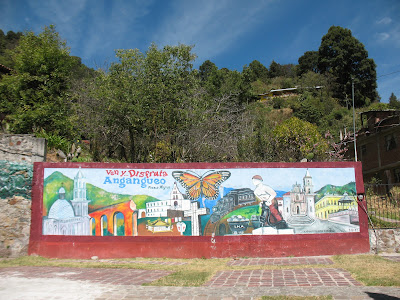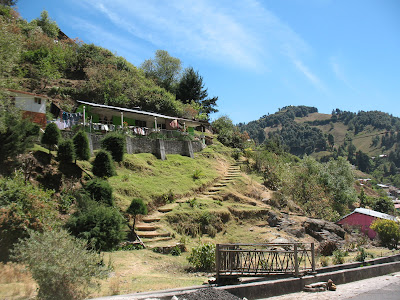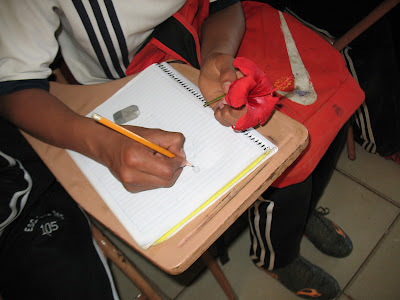Ceci Wright releasing monarch butterflies that her preschoolers raised in the classroom at St Casimir Catholic School in Baltimore City - Fall, 2019
Mexican girl in
Valle Verde modelling her costume for annual Monarch Festival, an event supported by MSSP - February, 2020
Monarch Sister Schools Program Newsletter: Spring, 2020
New
Member Schools! This school year we welcomed three new schools - Ashburton
Elementary in Bethesda, St Casimir School in Baltimore City, and St Joan of Arc
School in Aberdeen - into our Monarch butterfly “sisterhood,” led teacher
workshops at schools, taught environmental education, and helped plant or
renovate pollinator habitat gardens. Our
ongoing school members include Hampton Elementary School in Lutherville, Pot
Spring Elementary School in Timonium, Tidewater School in Huntingtown, and Westowne
Elementary School in Catonsville. Many
of the schools participated in our Cultural Exchange with a sister school in
Mexico’s Monarch Butterfly Biosphere Reserve via class-to-class Skype
sessions. Students bridged borders to
exchange information about their school, local traditions, and their school’s
Monarch-related projects (See Cultural Exchange below for more details.). One teacher even travelled with us to Mexico
for our annual trip to Monarch Country, to meet the students at her school’s
sister school, and to become better prepared to teach her students about the
butterflies, their migration, and Mexican cultures.
Annual memberships for all current member schools have been extended through the 2020-2021 school year due to the pandemic.
If your school is interested in joining, contact Molly O. Hoopes, mhoopes.mssp@gmail.com in the Baltimore city or county areas, or William Dent, williamdenttjr@gmail.com in other locations.
Adding
New Locations at Each End: We are adding sister
schools in Mexico City; previously, all of our Mexican sister schools have been
in Valle Verde near the monarch sanctuary.
Habitat
Restoration: Students Planting Gardens
This year was a
difficult one for school gardens, because of schools shutting down for Covid19,
but some teachers, like Tracey Tokarski at St Joan of Arc School in Aberdeen continued to maintain schoolyard habitats in their spare
time. We were able to provide vegetable
starter plants for some school gardens, just in case school was to open back
up. We tried to keep teachers updated on where to purchase native plants and vegetable
plants for the gardens during this time of so many closings. If the garden is planted now, students will
be able to harvest some vegetables, like pumpkins, in the fall, if school
reopens. Or they will see monarchs on
the milkweed or nectar plants. A
pollinator garden makes a perfect outdoor classroom for learning about the
monarch’s life cycle, habitat and amazing migration.
Virtual
Resources
Many teachers
are communicating with their students online nowadays. And many students are stuck at home with
limited resources. Baltimore Area
Coordinator Molly O. Hoopes has created a blogsite on google with Nature and
Art activities for parents to do with their children during the Covid pandemic. It includes things to do outside, ways to
bring Nature indoors, home gardening, art activities, and information about
local wildlife.
There are
also many online resources on the Baltimore City Recreation and Parks website… https://bcrp.baltimorecity.gov/virtual-rec
We are in
the process of developing virtual teacher trainings and lessons about monarch
butterflies, so keep a look out on the facebook page for MSSP for updates.
Even during
these uncertain times, the Baltimore city parks have remained open, and outside
is a healthy place to be as long as you maintain social distance and avoid
touching things like playground equipment.
There are many trails to explore through the woods and wildflowers,
wildlife, and insects to see in the meadows.
Check out
the Monarch Sister Schools Program facebook page … https://www.facebook.com/monarchsisterschools
and the one for the schools and programs we support in Mexico … https://www.facebook.com/EscuelasHermanasMexico
and one devoted to the annual Monarch Festival in Valle Verde … https://www.facebook.com/alasdelibertadFestival
Ashburton Elementary School in Bethesda, MD
Ellen Holder and other 2nd grade teachers at
Ashburton School, which recently joined the Monarch Sister Schools Program are
planning to involve their students in learning about monarch butterflies in the
classroom, whenever school starts back up again.
Ashburton Elementary School has several possible areas for expansion of its gardens.
Kerry Pawliske,
Green School Coordinator for Hampton Elementary School, has been helping
maintain the beautiful school pollinator garden planted in Spring of 2019.
Wendy Cardwell
attended a Monarchs and More workshop in September, 2019, where she made a cage
to use for raising monarchs in the classroom.
Spanish Teacher
Concetta Gallardo facilitated a Skype session for her 5th grade
students with a Mexican class in January, 2020, in which students practiced
their Spanish by asking questions and telling about their favorite sports.
Pot
Spring Elementary School in Timonium, MD
Diana Moore,
Kindergarten teacher and Green Team Coordinator at Pot Spring Elementary
School, has been helping students plant and maintain the school meadow,
Bayscape garden, and butterfly garden. In October, 2019, Baltimore Area
Coordinator Molly Hoopes led a program for 4th- graders on the Green
Team about monarch butterfly migration. Kindergarteners
found monarch caterpillars in the Bayscape garden in September and watched them
turn into butterflies in the classroom, then enjoyed releasing them into the
Bayscape garden.
St
Casimir Elementary School in Canton in Baltimore City
Cecelia Wright envisioned
and established the school pollinator garden in May of 2019. Master Gardener
Peggy Cumming helped St Casimir School plan and plant the garden, and watered
it over the summer. The garden includes
asters, echinacea, phlox, liastrus, and, of course, swamp milkweed for the
monarchs. There are even fruit trees!
In fall, 2019, Lead Teacher Cecelia Wright at St. Casimir
Catholic School involved her preschoolers in a variety of monarch butterfly
activities in the classroom. The
students did a project showing the life cycle of the butterfly. They enjoyed playing with a monarch life
cycles puppet, making the larva turn into a butterfly. They also took turns naming the stages of
monarch development on a life cycle poster.
Ceci obtained six or seven larvae at the annual FREE
Monarch Sister Schools Teacher Workshop in September, made a cage with
household supplies provided at the workshop, and raised the larvae in the
classroom. Students learned a difficult
lesson when only two of the larvae they raised made it to adulthood. An additional caterpillar succeeded in making
a chrysalis but never emerged as a butterfly, possibly due to predation by a
wasp which lays its eggs in the caterpillar.
The butterfly release was an exciting event nevertheless with the
three-year-old group releasing one and the four-year-olds releasing the other.
St Casimir School has been paired with school Leona Vicaro in
Valle Verde, Mexico, and plans to set up a Skype session with the help of the
new Spanish teacher who started in November.
Whenever school is back in session, 8th and 3rd graders will
pair up and talk to Mexican students via Skype.
St Joan of Arc School in Aberdeen, MD
St Joan of Arc School has a 20’ X 30’ garden, designed and
created by the middle school students in 2018.
Each year, different classrooms grow annuals to add to the garden. It is registered as an official Waystation
for monarch butterflies. While school
has been out due to Covid19, teacher Tracey Tokarski has been tending the
garden. She was fortunate to have been
able to join the Monarch Sister Schools Program on our annual tour to Mexico in
February to see the monarch butterflies in their wintering grounds. When schools open back up, students will
participate in Skype sessions with Mexican students at the school Tracey
visited while on the trip.
 Joan of Arc School's schoolyard garden, complete with milkweed, nectar plants, signs, and a water source
Joan of Arc School's schoolyard garden, complete with milkweed, nectar plants, signs, and a water source
Left Photo: Tracey Tokarski from St Joan of Arc School in Aberdeen looking for
monarch larvae on tropical milkweed in the Leona Vicaro school garden in Valle
Verde, Mexico, near the monarch sanctuary, whuile on the annual Mexico Monarch Country Tour with MSSP in February Right Photo: Mexican teacher at Leona Vicaro School with a cage full of monarch larvae from eggs found in the school garden. Local children raise the butterflies in the classroom and are being encouraged to protect the monarchs and their habitat. Some monarchs, like these, stay in Mexico year-round instead of migrating.
Baltimore
Montessori Public Charter School
BMPCS had so
many teachers interested in focusing on monarch butterflies, that we taught a
Teacher Workshop at their school, demonstrating various ways to teach about
monarchs in the classroom. The school
has a large garden area out back, in addition to a chicken coop with
chickens! Some of the chickens have succumbed to fox and hawk attacks, but MSSP will be providing some replacements when school opens back up.
Different grades are
responsible for different aspects of the gardens. Students even cook and clean in the student
kitchen! We are looking forward to
getting more involved with this school. They already incorporate hands-on learning
with their students and want to add curriculum involving monarch butterflies. The Monarchs and More Curriculum Guide that MSSP sells is a good resource!
Students of
Tele-Bachillerato High School (a MSSP sister school) continue to nurture tree
seedlings in the nursery at their school to plant in and near the Monarch
Reserve. This project is funded in part
by MSSP, as is the annual Monarch Festival in Valle Verde and the Internet
access for the sister schools in Mexico who Skype with the students her in Maryland.
 Yizuz Arriaga, MSSP Mexican school coordinator, talking about the school tree nursery at "Forest Middle School" in Valle Verde
Yizuz Arriaga, MSSP Mexican school coordinator, talking about the school tree nursery at "Forest Middle School" in Valle Verde
 Yizuz Arriaga, MSSP Mexican school coordinator, talking about the school tree nursery at "Forest Middle School" in Valle Verde
Yizuz Arriaga, MSSP Mexican school coordinator, talking about the school tree nursery at "Forest Middle School" in Valle Verde Secondary school student watering tree seedlings in a Mexican school tree nursery we visited on our trip. Students plant the trees in or near the monarch sanctuary. In Maryland, students mostly plant milkweed and nectar plants, while in Mexico the students mostly plant trees, because while in Mexico for the winter months, the monarchs need a safe place to shelter from the cold, while in the states and in Canada, they need food and a place to lay eggs.
Secondary school student watering tree seedlings in a Mexican school tree nursery we visited on our trip. Students plant the trees in or near the monarch sanctuary. In Maryland, students mostly plant milkweed and nectar plants, while in Mexico the students mostly plant trees, because while in Mexico for the winter months, the monarchs need a safe place to shelter from the cold, while in the states and in Canada, they need food and a place to lay eggs. Annual Mexico Monarch Country Tour 2020
Eleven participants, including a teacher from St Joan of Arc School in Aberdeen, joined William Dent, Trip Coordinator, and Molly O. Hoopes, Baltimore Area Coordinator for MSSP and Naturalist for Baltimore City Rec & Parks, for the annual trip to Mexico February 21 - 26th. The trip began in Mexico City with a walking tour to the Monument of the Revolution, family-friendly Alameda Park, and Palacio de Bellas Artes, followed by dinner at the beautiful Casa de los Azulejos. The group stayed at Hotel Casa Blanca, whcih served a huge breakfast buffet. The second day included tours (w/ birding) of Chapultepec Park, the Historic District and major sights around the Zócalo, including the Cathedral, (Aztec) Templo Mayor and the Palacio Nacional. Afterwards, a sumptious meal with live music and guacamole. Next day were guided tours of the Temples of the Sun and Moon and the Avenue of the Dead in Teotihuacan, and a guided tour of the famous National Museum of Anthropology.
The next couple days, we stayed at the Hotel Villa Monarca near Valle Verde and visited several local schools growing trees to plant in the monarch sanctuary and preparing for the annual Monarch Festival.
We visited Alternare's school of sustainable agriculture, a free 9-month program for local youth who wish to acquire sustainable agriculture methods to take back to their communities.
The highlight of the trip, of course, was a visit to the Monarch Sanctuary in el Rosario to see the amazing butterflies at their wintering grounds.
 |
| Monarchs filling the sky |
 |
| Monarchs clustered on oyamel trees in Monarch Sanctuary |
 |
 |
| playground at Hotel Villa Monarca |
 |
| Delicious chilaquiles for breakfast (desayuno) at Hotel Villa Monarca |
William and Molly stayed an extra two days to participate in the annual Monarch Festival in Valle Verde. William met with people to make plans to expand the MSSP program in Mexico.
Molly returned to the monarch sanctuary to sit and paint wildflowers along the trail. When we protect the monarchs, we also are protecting their habitat. They are relegated to a small unique area of oyamel forest in the Central highlands of Mexico on the border of Mexico state and Michoacan state. In addition to the monarch butterflies, this area has many endemic plants. Next time we do the tour, she will be leading botanical art workshops in the sanctuary for any trip participants wishing to document some of these beautiful wildflowers as a personal souvenir while experiencing the serenity of the forest.
As part of the Monarch Festival, Molly taught some botanical art workshops to middle-schoolers at the "Forest Middle School," in an effort to help students realize how precious and unique their forest is. The school mothers fed her breakfast, and Yizuz Arriaga's family fed her comida before the parade. They dressed her up in traditional costume with a full skirt for twirling and gave her a school sign to carry at the head of their group. Anyone attending the tour next time will have a similar opportunity to volunteer with the festival - painting costume wings, teaching workshops, marching in the parade, taking photos, or any other project that inspires you.










































































